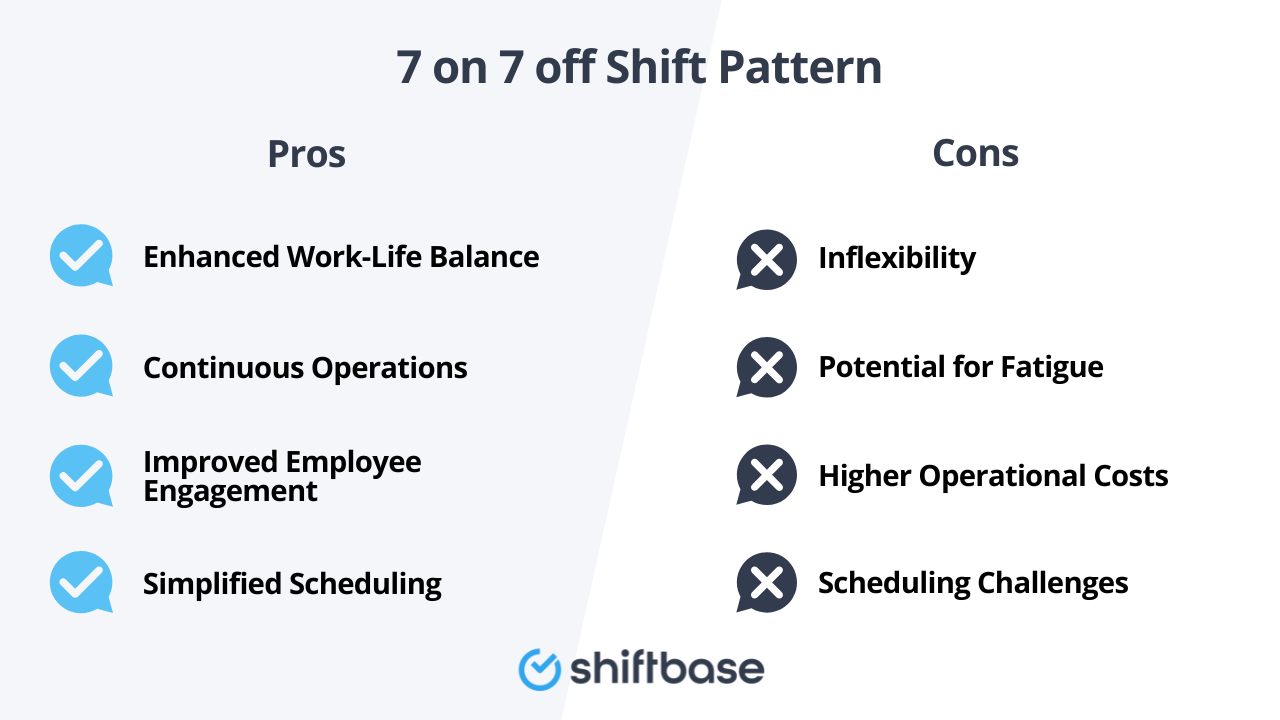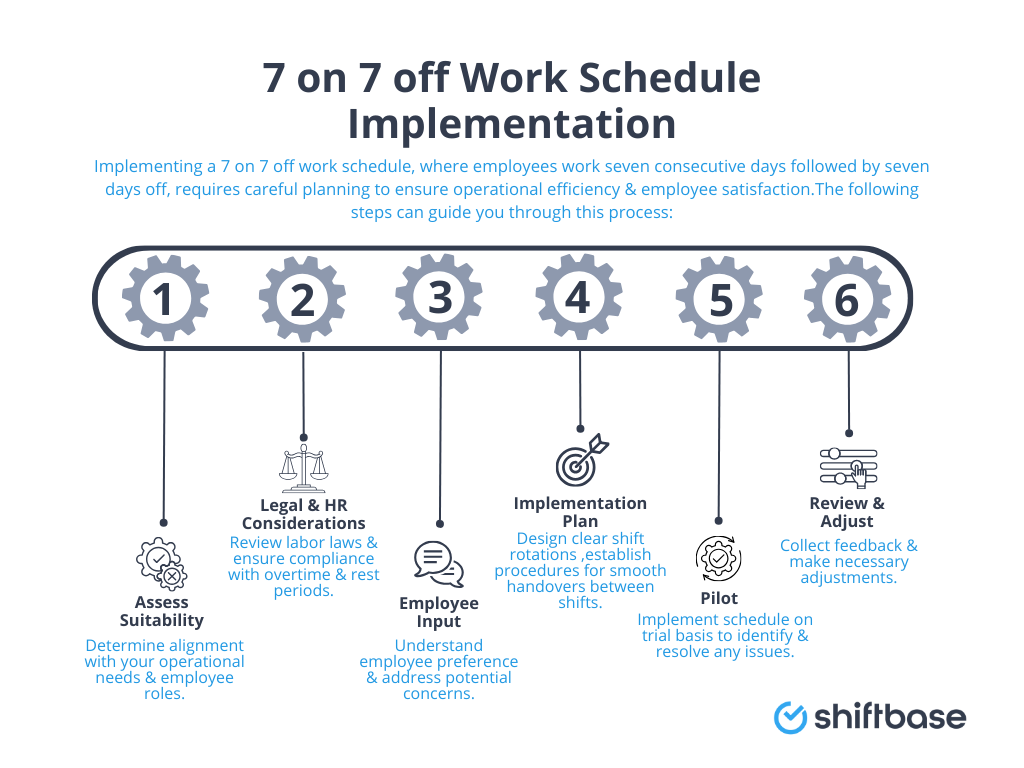This article aims to demystify the 7/7 work schedule, a model where employees work seven consecutive days and then enjoy seven days off.
What is a 7 on 7 off work schedule?
The 7/7 work schedule, commonly known as the '7 on 7 off schedule,' is an innovative work arrangement. In this model, employees work for seven consecutive days, typically in 12-hour shifts, followed by seven days off. This means that during their work week, employees are highly focused and dedicated for a stretch of seven days.
After this intense work period, they get an entire week to rest and engage with family, friends, and personal interests. Unlike the standard five days a week schedule, the 7/7 model compresses the work hours into a single row of days, offering a unique approach to managing work and life.
Pros and cons of the 7 on 7 off Schedule
Implementing a 7 on 7 off work schedule, where employees work seven consecutive days followed by seven days off, presents several advantages and disadvantages for employers. Here's a detailed overview:
Advantages:
-
Enhanced Work-Life Balance: Employees benefit from extended periods off, allowing them to rest, pursue personal interests, or manage personal commitments, which can lead to increased job satisfaction and morale.
-
Continuous Operations: This schedule ensures that operations run smoothly without interruption, as employees are available for a full week, providing consistent coverage and reducing the complexity of daily shift changes.
-
Improved Employee Engagement: Longer periods off can lead to employees returning to work more refreshed and motivated, potentially enhancing productivity and reducing burnout and absenteeism.
-
Simplified Scheduling: The 7 on 7 off model offers a straightforward and predictable scheduling framework, making it easier for employers to manage staffing needs and for employees to plan their personal activities around their work commitments.
Disadvantages:
-
Inflexibility: The rigid nature of the 7 on 7 off schedule can make it challenging for employees to attend personal events or handle unexpected commitments during their workweek, as swapping shifts may be difficult.
-
Potential for Fatigue: Working seven consecutive days, especially in demanding roles, can lead to employee fatigue, impacting performance and increasing the risk of errors or accidents.
-
Higher Operational Costs: To maintain continuous coverage, employers may need to hire additional staff or pay overtime, leading to increased labor costs.
-
Scheduling Challenges: Coordinating handovers and ensuring effective communication between teams can be complex, requiring meticulous planning to maintain productivity and service quality.
While the 7 on 7 off schedule offers benefits like improved work-life balance and continuous operations, it also presents challenges such as potential employee fatigue and higher operational costs. Employers should carefully assess their specific operational needs, workforce dynamics, and industry requirements before implementing this schedule to ensure it aligns with organisational goals and employee well-being.

Industries and roles where the 7/7 schedule is most prevalent.
The 7/7 schedule is frequently adopted in industries where round-the-clock operations are essential. These include:
-
Healthcare: Nurses, doctors, and support staff often work 12-hour shifts in a row, especially in critical care and emergency departments.
-
Oil and Gas: Employees in drilling and extraction often follow this schedule due to the remote location of facilities and the need for continuous operation.
-
Law enforcement and emergency services: Police officers, firefighters, and paramedics may work a series of long shifts followed by an extended period of rest.
-
Hospitality and tourism: In some resorts and tourist attractions, staff work extended hours for a week and then have the next week off.
Legal considerations
Implementing a 7 on 7 off work schedule, requires careful consideration of various legal aspects to ensure compliance with U.S. labor laws. Employers should be mindful of the following key areas:
1. Overtime Compensation
Under the Fair Labor Standards Act (FLSA), non-exempt employees must receive overtime pay for hours worked over 40 in a workweek. In a 7 on 7 off schedule with 12-hour shifts, employees work 84 hours in one week, necessitating overtime compensation for 44 hours. It's crucial to calculate and compensate overtime accurately to adhere to federal regulations.
2. State-Specific Regulations
Some states impose additional requirements beyond federal laws. For instance:
-
California: Mandates one day of rest in seven and daily overtime for work exceeding eight hours.
-
New York: Limits non-exempt employees to 60 hours per week unless they receive 1.5 times their regular pay for hours beyond 40.
Employers must review and comply with state-specific labor laws to avoid legal complications.
3. Rest Periods and Meal Breaks
While the FLSA does not mandate rest or meal breaks, many states have laws requiring them. For example, California requires a 30-minute meal break for every five hours worked. Employers should familiarise themselves with applicable state laws to ensure compliance.
4. Alternative Workweek Agreements
In certain jurisdictions, employers can implement alternative workweek schedules without incurring daily overtime, provided they follow specific procedures, such as obtaining employee consent and filing with the appropriate state agency. It's essential to understand the legal framework governing such agreements in your state.
5. Record keeping and Documentation
Accurate record keeping of hours worked, overtime, and rest breaks is vital. The FLSA requires employers to maintain precise records to demonstrate compliance with wage and hour laws. Proper documentation can also serve as evidence in case of disputes or audits.
6. Recent Legal Developments
Employers should stay informed about recent legal decisions affecting labor practices. For instance, a January 2025 U.S. Supreme Court ruling clarified that employers need only prove by a preponderance of the evidence that workers qualify for exemptions under the FLSA, simplifying defense strategies in wage-related lawsuits.
Implementing a 7/7 work schedule
Implementing a 7 on 7 off work schedule, where employees work seven consecutive days followed by seven days off, requires careful planning to ensure operational efficiency and employee satisfaction. Here are the key steps for employers to consider:
1. Assess Suitability
-
Evaluate Operational Needs: Determine if continuous coverage is essential for your operations and if the 7 on 7 off schedule aligns with your business objectives.
-
Analyse Job Roles: Identify positions suitable for extended shifts and assess whether employees can maintain performance during longer work periods.
2. Understand Legal and HR Considerations
-
Compliance with Labor Laws: Ensure adherence to federal and state labor regulations, including overtime pay and mandatory rest periods.
-
Overtime Implications: Recognize that working 84 hours in one week may necessitate overtime compensation for 44 hours, depending on jurisdiction.
-
Employee Well-being: Consider potential impacts on health and work-life balance, addressing concerns related to fatigue and burnout.
3. Gather Employee Input
-
Conduct Surveys or Meetings: Engage employees to understand their shift preferences, concerns, and suggestions regarding the new schedule.
-
Assess Impact on Morale: Evaluate how the schedule might affect job satisfaction and retention.
4. Develop a Detailed Implementation Plan
-
Design Shift Rotations: Create clear and consistent shift patterns, ensuring fair distribution of workdays and off days.
-
Plan for Handoffs: Establish procedures for seamless transitions between shifts to maintain productivity and communication.
5. Pilot the Schedule
-
Trial Period: Implement the schedule on a trial basis to identify potential issues and gather feedback.
-
Monitor Performance: Assess operational efficiency and employee well-being during the pilot phase.
6. Review and Adjust
-
Collect Feedback: Solicit input from employees and supervisors on the schedule's effectiveness.
-
Make Necessary Adjustments: Modify the schedule based on feedback and operational needs to optimize outcomes.
By following these steps, employers can effectively implement a 7 on 7 off work schedule that balances operational demands with employee well-being.

Conclusion
The 7/7 work schedule presents a unique and flexible approach to managing work and rest periods, offering potential benefits like improved work-life balance and increased productivity. However, it's important for businesses to carefully consider the challenges and implications of such a schedule.
By thoughtfully assessing its suitability, engaging with employees, ensuring legal compliance, and being open to adjustments based on feedback and data, employers can successfully implement a 7/7 schedule.
This approach not only meets operational needs but also supports the well-being and satisfaction of employees, fostering a more dynamic and responsive workplace.
Enhancing work-life balance with 7 on 7 off schedules via Shiftbase
Implementing a 7 on 7 off work schedule is streamlined with Shiftbase, a comprehensive workforce management SaaS. Its employee scheduling feature perfectly adapts to the unique requirements of this balanced work-rest pattern, ensuring smooth operations in industries like healthcare. Shiftbase's time tracking tool accurately captures the intensive work hours of the 7-day stretch, essential for fair compensation and compliance.
Additionally, the absence management system effectively handles the week-long breaks, ensuring staffing levels are optimally maintained.
Experience the benefits of Shiftbase for your 7 on 7 off scheduling needs by signing up for a 14-day free trial here. Streamline your scheduling and enhance workforce efficiency with Shiftbase.

Your work schedule in one central place!



